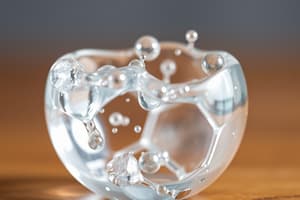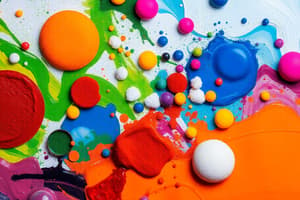Podcast
Questions and Answers
What is matter?
What is matter?
A physical substance.
List at least five common physical properties.
List at least five common physical properties.
Appearance, texture, color, odor, melting point, boiling point, density.
Iron and oxygen form rust. Is this chemical or physical?
Iron and oxygen form rust. Is this chemical or physical?
- Chemical (correct)
- Physical
Iron is more dense than aluminum. Is this chemical or physical?
Iron is more dense than aluminum. Is this chemical or physical?
Magnesium burns brightly when ignited. Is this chemical or physical?
Magnesium burns brightly when ignited. Is this chemical or physical?
Mercury melts at -39°C. Is this chemical or physical?
Mercury melts at -39°C. Is this chemical or physical?
Describe the difference between an element and a compound.
Describe the difference between an element and a compound.
Distinguish between three states of matter based on their shape, volume, and compressibility.
Distinguish between three states of matter based on their shape, volume, and compressibility.
Describe the difference between a mixture and a pure substance.
Describe the difference between a mixture and a pure substance.
What is gold (Au)?
What is gold (Au)?
What is vegetable soup?
What is vegetable soup?
What is saltwater?
What is saltwater?
What is table salt (sodium chloride)?
What is table salt (sodium chloride)?
What is the difference between a heterogeneous mixture and a homogeneous mixture?
What is the difference between a heterogeneous mixture and a homogeneous mixture?
Distinguish between suspensions and colloids.
Distinguish between suspensions and colloids.
You shine a beam of light through a colorless liquid and the beam cannot be seen through the liquid. Is this a homogeneous or a heterogeneous mixture? Explain your answer.
You shine a beam of light through a colorless liquid and the beam cannot be seen through the liquid. Is this a homogeneous or a heterogeneous mixture? Explain your answer.
Why would it not work to filter the saltwater mixture?
Why would it not work to filter the saltwater mixture?
Propose another method for separating water from salt in a saltwater mixture.
Propose another method for separating water from salt in a saltwater mixture.
Flashcards
What is matter?
What is matter?
Anything that has mass and takes up space.
What are physical properties?
What are physical properties?
Characteristics of matter that can be observed or measured without changing the substance's chemical makeup.
What is a chemical change?
What is a chemical change?
A change in the chemical composition of a substance, resulting in a new substance with different properties.
What is a physical change?
What is a physical change?
Signup and view all the flashcards
What is an element?
What is an element?
Signup and view all the flashcards
What is a compound?
What is a compound?
Signup and view all the flashcards
What are the characteristics of a solid?
What are the characteristics of a solid?
Signup and view all the flashcards
What are the characteristics of a liquid?
What are the characteristics of a liquid?
Signup and view all the flashcards
What are the characteristics of a gas?
What are the characteristics of a gas?
Signup and view all the flashcards
What is a mixture?
What is a mixture?
Signup and view all the flashcards
What is a pure substance?
What is a pure substance?
Signup and view all the flashcards
What is a homogeneous mixture?
What is a homogeneous mixture?
Signup and view all the flashcards
What is a heterogeneous mixture?
What is a heterogeneous mixture?
Signup and view all the flashcards
What is a suspension?
What is a suspension?
Signup and view all the flashcards
What is a colloid?
What is a colloid?
Signup and view all the flashcards
Is saltwater a homogeneous or heterogeneous mixture?
Is saltwater a homogeneous or heterogeneous mixture?
Signup and view all the flashcards
Is muddy water a homogeneous or heterogeneous mixture?
Is muddy water a homogeneous or heterogeneous mixture?
Signup and view all the flashcards
How can you separate salt from a saltwater mixture?
How can you separate salt from a saltwater mixture?
Signup and view all the flashcards
Study Notes
Classification of Matter
- Matter is defined as a physical substance in the universe.
- Common physical properties include appearance, texture, color, odor, melting point, boiling point, and density.
Types of Changes
- Iron and oxygen creating rust exemplifies a chemical change.
- Iron's density compared to aluminum is an example of a physical property.
- Combustion of magnesium, which burns brightly, is a chemical change.
- Melting of mercury at -39°C represents both chemical and physical properties.
Elements vs. Compounds
- An element consists entirely of one type of atom.
- A compound is formed from two or more chemically bonded elements.
States of Matter
- Solid: Has a definite shape and volume; difficult to compress.
- Liquid: Takes the shape of its container, has a definite volume; hard to compress.
- Gas: Fills its container, has no definite volume; easy to compress.
Mixtures vs. Pure Substances
- Pure substances can be classified into elements and compounds.
- Mixtures consist of physically combined substances that can be separated back into their original components.
Types of Mixtures
- Homogeneous Mixture: Uniform appearance and composition, often referred to as a solution.
- Heterogeneous Mixture: Consists of visibly different substances or phases.
Suspensions vs. Colloids
- Suspensions contain larger dispersed particles that eventually settle out, forming sediment.
- Colloids consist of smaller, undissolved particles that remain evenly distributed and do not settle.
Examples and Separation Techniques
- Gold (Au) is classified as a substance.
- Vegetable soup and saltwater are examples of mixtures.
- Table salt (sodium chloride) is a compound.
- Filtering saltwater is ineffective because it has no solid particles; boiling is a proposed method to separate water from salt through evaporation.
Studying That Suits You
Use AI to generate personalized quizzes and flashcards to suit your learning preferences.




